Dev Blog
Hi, this is the Stranded III development blog (see also Forum Thread, Comment Thread).
Entry 88 - Right In The Face - September 15, 2019
Blender 2.80
Hooray! Blender 2.80 is finally officially released and I switched to the latest version.
I love Blender and I highly recommend everyone to use it. It's great software and it's free!
and I highly recommend everyone to use it. It's great software and it's free! 
They made 2.80 much more user friendly with fancy icons and an improved UI. This way you don't have to remember so many shortcut key combinations.
What I dislike about the new update is that all textures on existing models are now gone. This is because they introduced a new material system which is not compatible with the old solution.
It's pretty annoying that I now have to go over every model and fix the textures. Too bad that they didn't add automatic migration/conversion for that. So sad.
Epic Emotion Mega Mimic Ultra True Face HD©™
Remember the last post were I mentioned my humanoid model and its boring flat face?
There's a very good reason for that flat face!
Please let me proudly present my innovative Epic Emotion Mega Mimic Ultra True Face HD©™ system!
For that system I started drawing some funny little face parts here
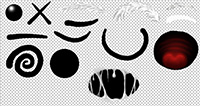
(more to come!)
Surprise! These parts can be placed on the flat face! WOAH! Mind blown!
Not only that! ALL these parts can be FREELY positioned, scaled (including mirroring!), rotated and even color tinted.
This allows creating an unlimited amount of variation and really crazy looking faces.
My aim is to build a little editor and system which allows me to easily create different faces and maybe even facial animations.
Technically this is just a set of flat textured quads which are placed in front of the face mesh geometry with tiny distance to prevent intersections and flickering / z-fighting.
Note that the following samples are manually crafted for demonstration purposes (the implementation is not fully done yet):
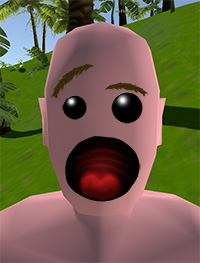
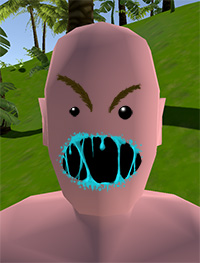
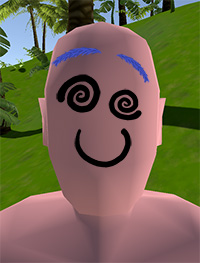
This is only the beginning! Eyes, optional eyebrows and a mouth are just the most basic elements.
There could also be red cheeks, scars, mustaches, pimples, freckles, tribal face paintings and much more.
What I won't add there though are noses. Noses look stupid.
Gradients And Terrain Textures
I'm using simple gradients to make transitions between sand and grass (and other terrain types) more smooth.
Well... this is what it can look like when you don't do the calculations right. No worries, already fixed that
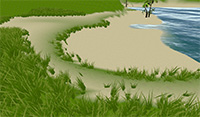
Terrain textures on this shot are not final!
If you look closely however you can - with some imagination - see that grass and sand use different textures. This is already better than what Stranded II offered. In Stranded II there only was just one single detail texture and one color texture for different colors.
For Stranded III I now decided to write a simple shader which blends up to 5 textures using the vertex RGBA values:
 base: sand texture (visible if RGB is 0 / black)
base: sand texture (visible if RGB is 0 / black)
 red: grass texture
red: grass texture
 blue: rock texture
blue: rock texture
 green: grayscale detail/dirt texture
green: grayscale detail/dirt texture
 alpha channel: color gradient. based on the alpha value a different color will be multiplied with the texture(s) which will be rendered
alpha channel: color gradient. based on the alpha value a different color will be multiplied with the texture(s) which will be rendered
Stranded III in Unity Editor
In case anyone wondered: This is what a Stranded III island with opened in-game console looks like in the Unity editor with wireframe on.
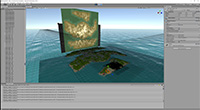
The darker area where the wireframe is really dense is where the player/camera currently is. This area is rendered with higher detail.
I selected a terrain chunk (orange with arrows) to show that the terrain actually consists of many small meshes.
Another fun thing you can observe in this shot is that the in-game console with a 2D representation of the 3D map is visible in the background.
This is because the user interface actually consists of meshes as well and is therefore displayed in this editor view.
Hooray! Blender 2.80 is finally officially released and I switched to the latest version.
I love Blender
 and I highly recommend everyone to use it. It's great software and it's free!
and I highly recommend everyone to use it. It's great software and it's free! 
They made 2.80 much more user friendly with fancy icons and an improved UI. This way you don't have to remember so many shortcut key combinations.
What I dislike about the new update is that all textures on existing models are now gone. This is because they introduced a new material system which is not compatible with the old solution.
It's pretty annoying that I now have to go over every model and fix the textures. Too bad that they didn't add automatic migration/conversion for that. So sad.
Epic Emotion Mega Mimic Ultra True Face HD©™
Remember the last post were I mentioned my humanoid model and its boring flat face?
There's a very good reason for that flat face!
Please let me proudly present my innovative Epic Emotion Mega Mimic Ultra True Face HD©™ system!
For that system I started drawing some funny little face parts here
(more to come!)
Surprise! These parts can be placed on the flat face! WOAH! Mind blown!
Not only that! ALL these parts can be FREELY positioned, scaled (including mirroring!), rotated and even color tinted.
This allows creating an unlimited amount of variation and really crazy looking faces.
My aim is to build a little editor and system which allows me to easily create different faces and maybe even facial animations.
Technically this is just a set of flat textured quads which are placed in front of the face mesh geometry with tiny distance to prevent intersections and flickering / z-fighting.
Note that the following samples are manually crafted for demonstration purposes (the implementation is not fully done yet):
This is only the beginning! Eyes, optional eyebrows and a mouth are just the most basic elements.
There could also be red cheeks, scars, mustaches, pimples, freckles, tribal face paintings and much more.
What I won't add there though are noses. Noses look stupid.
Gradients And Terrain Textures
I'm using simple gradients to make transitions between sand and grass (and other terrain types) more smooth.
Well... this is what it can look like when you don't do the calculations right. No worries, already fixed that

Terrain textures on this shot are not final!
If you look closely however you can - with some imagination - see that grass and sand use different textures. This is already better than what Stranded II offered. In Stranded II there only was just one single detail texture and one color texture for different colors.
For Stranded III I now decided to write a simple shader which blends up to 5 textures using the vertex RGBA values:
 base: sand texture (visible if RGB is 0 / black)
base: sand texture (visible if RGB is 0 / black) red: grass texture
red: grass texture blue: rock texture
blue: rock texture green: grayscale detail/dirt texture
green: grayscale detail/dirt texture alpha channel: color gradient. based on the alpha value a different color will be multiplied with the texture(s) which will be rendered
alpha channel: color gradient. based on the alpha value a different color will be multiplied with the texture(s) which will be renderedStranded III in Unity Editor
In case anyone wondered: This is what a Stranded III island with opened in-game console looks like in the Unity editor with wireframe on.
The darker area where the wireframe is really dense is where the player/camera currently is. This area is rendered with higher detail.
I selected a terrain chunk (orange with arrows) to show that the terrain actually consists of many small meshes.
Another fun thing you can observe in this shot is that the in-game console with a 2D representation of the 3D map is visible in the background.
This is because the user interface actually consists of meshes as well and is therefore displayed in this editor view.